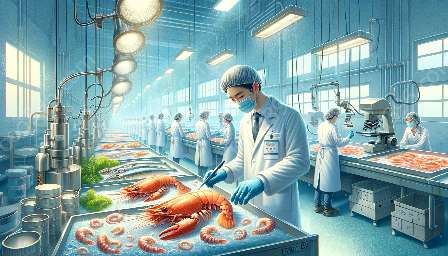Seafood serves as a vital source of nutrition worldwide. However, bacterial contamination poses a significant threat to seafood safety and sanitation. In this topic cluster, we'll explore the detection and control methods related to bacterial contamination in seafood within the context of seafood science and safety.
Understanding Bacterial Contamination in Seafood
Bacterial contamination in seafood can occur at various stages including harvesting, processing, distribution, and storage. Common bacterial pathogens found in seafood include Vibrio species, Escherichia coli, Salmonella, and Listeria monocytogenes. These pathogens can lead to severe health hazards if consumed, making it crucial to detect and control bacterial contamination in seafood.
Detection Methods
Several techniques are employed for the detection of bacterial contamination in seafood. These include:
- Microbiological Testing: Traditional methods such as culture-based techniques are used for the detection of specific bacteria in seafood samples.
- Molecular Techniques: PCR-based methods and DNA sequencing enable the rapid and accurate identification of bacterial pathogens in seafood.
- Biosensors: Advanced biosensor technology provides real-time detection of bacterial contamination in seafood, offering quick and reliable results.
Control Measures
Controlling bacterial contamination in seafood involves preventive measures and interventions such as:
- Good Manufacturing Practices (GMP): Adhering to GMP ensures proper hygiene and sanitation practices in seafood processing facilities, minimizing the risk of bacterial contamination.
- Hazard Analysis and Critical Control Points (HACCP): HACCP plans are essential in identifying and controlling potential hazards related to bacterial contamination, ensuring the safety of seafood products.
- Storage and Preservation Techniques: Proper storage temperature, use of antimicrobial packaging, and application of preservatives aid in controlling bacterial growth in seafood.
Seafood Safety and Sanitation
Ensuring seafood safety and sanitation is paramount to preventing bacterial contamination and its associated risks. Regulatory bodies, such as the FDA and WHO, play a crucial role in establishing standards and guidelines for seafood hygiene, processing, and transportation to safeguard the consumer.
Seafood Science
Seafood science encompasses disciplines like marine biology, food chemistry, and food safety, all of which contribute to understanding the complexities of seafood quality and safety. In the realm of bacterial contamination, seafood science focuses on innovative technologies and best practices to ensure the detection and control of pathogens.
By delving into the intricate domain of seafood safety, sanitation, and science, it becomes evident that the detection and control of bacterial contamination in seafood requires a comprehensive approach. Employing the latest detection methods and control measures not only preserves the integrity of seafood products but also promotes public health and consumer confidence.

